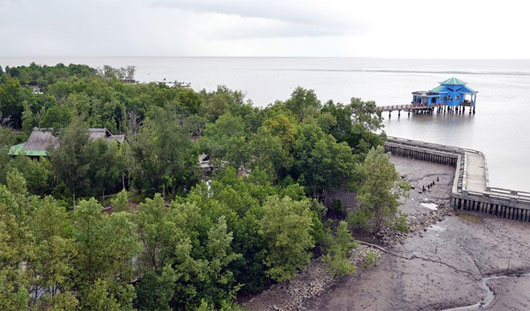The Mekong Delta risks being submerged under the sea
The delta plains, which are low-lying coastal areas, are at high risk when sea level rise due to climate change, the Mekong Delta is no exception.
According to the scenario of climate change and sea level rise in Vietnam announced by the Ministry of Natural Resources and Environment, the flooded area in the Mekong Delta to 2100 is likely to account for about 39% of the whole Delta area.
However, this is still not the worst picture because it has not considered the ground subsided over time, as the ground under the delta is very soft and constantly shrinking.
Subsidence of ground subsidence increases the speed of submergence
Currently, the settlement process is divided into shallow subsidence and deep subsidence. Deep subsidence is mainly related to excessive groundwater pumping, causing the reservoir to collapse and leading to lowering the above ground layers, resulting in the land surface being lowered.
When stopping or reducing the level of exploitation, the rate of deep subsidence will also gradually decrease. Farming subsidence is related to the process of soil consolidation and natural shrinkage, which is complicated by the composition of Holocene sediments.
Under the delta, deep layers of relatively compact and ancient sediments containing underground aquifers are often found, above which are younger deposits than muddy mud.

Ca Mau Cape, the southernmost of the Vietnamese Fatherland.(Photo: Thanh Ha / VNA)
Over time, due to the influence of self-gravity, these young sediments are compressed and squeezed out of water, causing their volume to be reduced to the ground that is constantly lowered. The speed of land surface reduction due to shallow subsidence is slow, difficult to detect in a short time on a large plain but long-term accumulation is the main factor, closely related to the existence or loss of a delta.
According to Dr. Le Xuan Thuyen, Center for Wetland Research at Ho Chi Minh City University of Natural Sciences, the results of shallow measurement at 3 coastal locations under mangrove forests, in the Mekong Delta region Long showed that the settlement speed is quite fast.
Specifically 26.3 mm / year in Can Gio, 14.2 mm / year at Song Hau estuary and 23.4 mm / year at Ca Mau Cape. These are areas with small scale of underground water exploitation, so the rate of deep subsidence is still low, but the rate of shallow subsidence is quite high.
In particular, in areas of bare land where mangroves have not yet recovered, subsidence rate is 1.6 times greater than the settlement rate in the intact forest area at the side. This shows the important role of mangroves in reducing land subsidence.
The results of the settlement process showed that the rate of water rise or submergence is actually the total value of the subsidence rate and the rate of sea level rise, the actual rate of water rise in the Mekong Delta is fast. 2 to 6 times more than the average sea level rise across the South China Sea.
Long-term solution restricts the subsidence effect
According to Dr. Le Xuan Thuyen, strengthening the use of sediment is one of the solutions to limit subsidence effect. The Mekong Delta is made up of river silt, which is still ongoing in the floodplain. However, this process is being intervened too much and in the flooded area, alluvial deposits mostly settle in the canal as in Long Xuyen Quadrangle.
A large amount of sediment is then deposited on the field thanks to the pumping process to irrigate rice. Therefore, irrigation management should be well managed to enhance sediment deposition in the field, which in the long term will contribute to improving the soil base without significantly increasing costs.
Besides, the exploitation and use of groundwater resources is inevitable, but it is necessary to calculate for more rational use, or limit the use of groundwater when surface water sources in the Mekong Delta are still available. can exploit. Because overexploitation will increase the rate of subsidence. In addition, the quality of groundwater in this area also has a high risk of accumulating arsenic in the water layers.
Maintaining the sediment source to nourish the mangrove forest is also one of the important solutions to limit subsidence. Mangroves have a protective role, but forest land is also subsided quickly and so that forests can withstand waves and sea level rise, they always need to support mud and sand. Therefore, it is necessary to limit actions to prevent tidal currents from bringing sediment into the forest to embank dikes and dams. This is also to maintain the interaction and metabolism between mangroves with inland and coastal areas.
- Environmental protection of surface water in the Mekong Delta
- The whole Mekong Delta is subsiding at a rate of nearly 2.5cm per year
- Losing 40% of the Mekong Delta if the sea level rises by one meter
- 30 years for a sustainable agriculture
- H1N1 flu broke out in the Mekong Delta
- The Mekong Delta provinces are penetrated by saltwater 70km deep
- Do not dig more channels in the forest
- Brag about the
- Bird flu recurrence in the Mekong Delta: The epidemic is expanding!
- Protection of mangrove ecosystem in Mekong Delta
- 'Should postpone dam construction on the Mekong for 10 years'
- AusAID grants clean water to poor people in the Mekong Delta
 Is the magnetic North Pole shift dangerous to humanity?
Is the magnetic North Pole shift dangerous to humanity? Washington legalizes the recycling of human bodies into fertilizer
Washington legalizes the recycling of human bodies into fertilizer Lightning stone - the mysterious guest
Lightning stone - the mysterious guest Stunned by the mysterious sunset, strange appearance
Stunned by the mysterious sunset, strange appearance